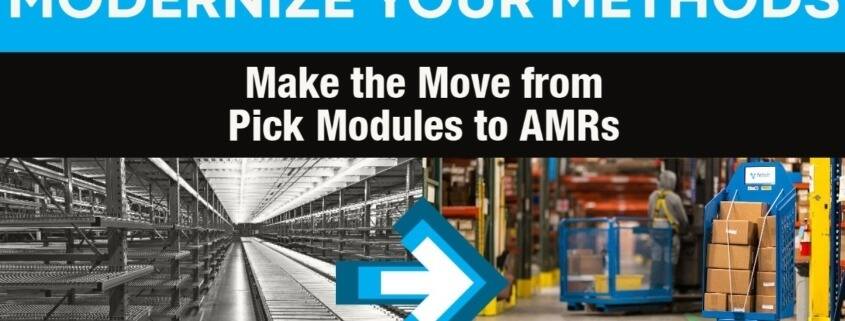AMRs are efficient for material transport
If there is one pain point we hear most often from operations managers, they are always fighting a battle between what they need to accomplish today versus preparing for changes down the road. The priority always defaults to ensure that day-to-day operations remain steady, restricting the amount of planning one could be doing.
Often, the operation team doesn’t know what is coming down the road. The team is often blind to the decision to add a new product, remove a product, or some other mandate that will require a new aisle or a lane to their storage configuration. However, especially in the age of Amazon, those changes are coming faster than before. The change is happening regardless — “when” not “if.”
Traditionally, pick modules have been constructed along with a conveyor system within a facility to optimize the fulfillment process. The pick modules and conveyance systems can be seen essentially as giant monuments within a facility. Costly and inflexible, multi-level structures have been “how things have been done” for so long that even the most attuned manager may not realize that alternatives exist. Not only do they exist, but they may also make more sense for certain operations.
Pick modules are becoming the “old school” way to process orders. Technology continues to evolve, and new processes have shown that perhaps that old-school way of thinking may be outdated. Especially when it comes to adaptability, the types of changes you can make with a pick module or a conveyor are limited. What can an operations manager do when a change is required?
In response, we have seen facilities create several efficiencies and save resources by switching to a more “new school” methodology by modernizing using autonomous mobile robots. By automating material transport with AMRs, you can see all the same benefits of the traditional pick module/conveyor system, without the massive investment in infrastructure.
The thought behind the process is the same: You can conduct the same picking operation, but you pick in an environment where everything is on the ground. Instead of using the inflexible conveyor to move products, you utilize the AMRs. Instead of the multi-tiered structure, you can use vertical storage space to store safety stock or reserve inventory. Plus, you still save the steps – and time – for your employees to move products down the line.
The real advantage of this system is how quickly you can adapt to the next change. Let’s face it: consumer demands and behavior will continue to change, but it is unlikely that change will come in the form of slower expectations with a greater appreciation for errors. Using cloud-based on-demand automation software, changes in processes can be quickly made via a mobile device. That is a little easier than installing a new “monument” to an old school way of thinking.
The costs are similar, especially when you consider the ongoing maintenance costs that come with the conveyor. By adopting this “new school” way of thinking, you set yourself up to adapt to the next change in the fulfillment process. This is the type of investment that can see returns early through efficiencies and continue delivering for years to come.
When it comes to investing in the future of your operations, the decision isn’t always easy. However, learning more is.
Our Solutions Development team would love to learn more about the challenges you face and develop a simple, smart, and strategic way to address those concerns for the future while understanding the need to fight the fires that come with managing day-to-day operations in a distribution center. We’re here to help – give us a call today!




